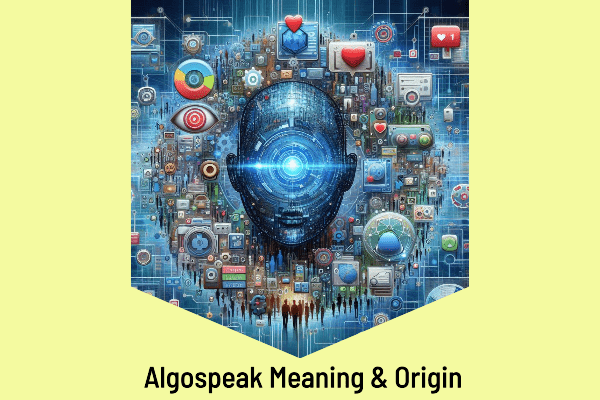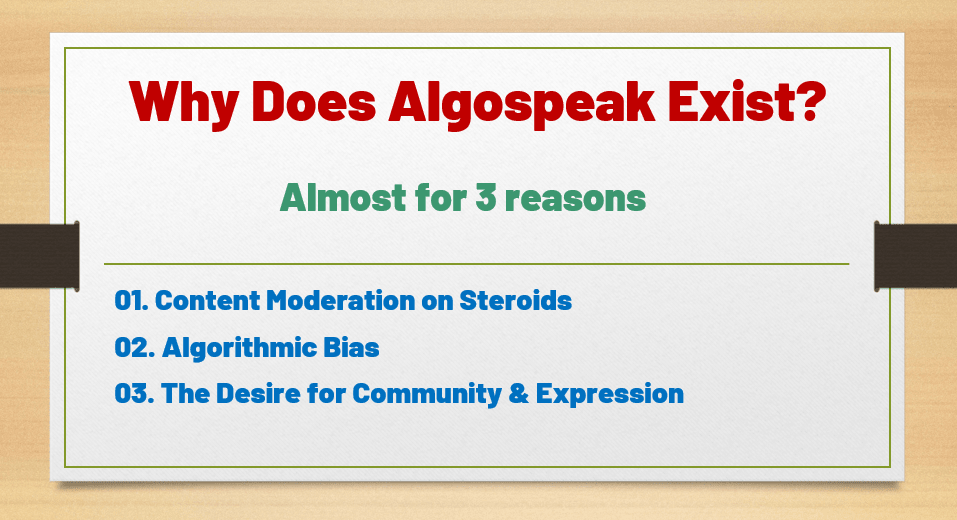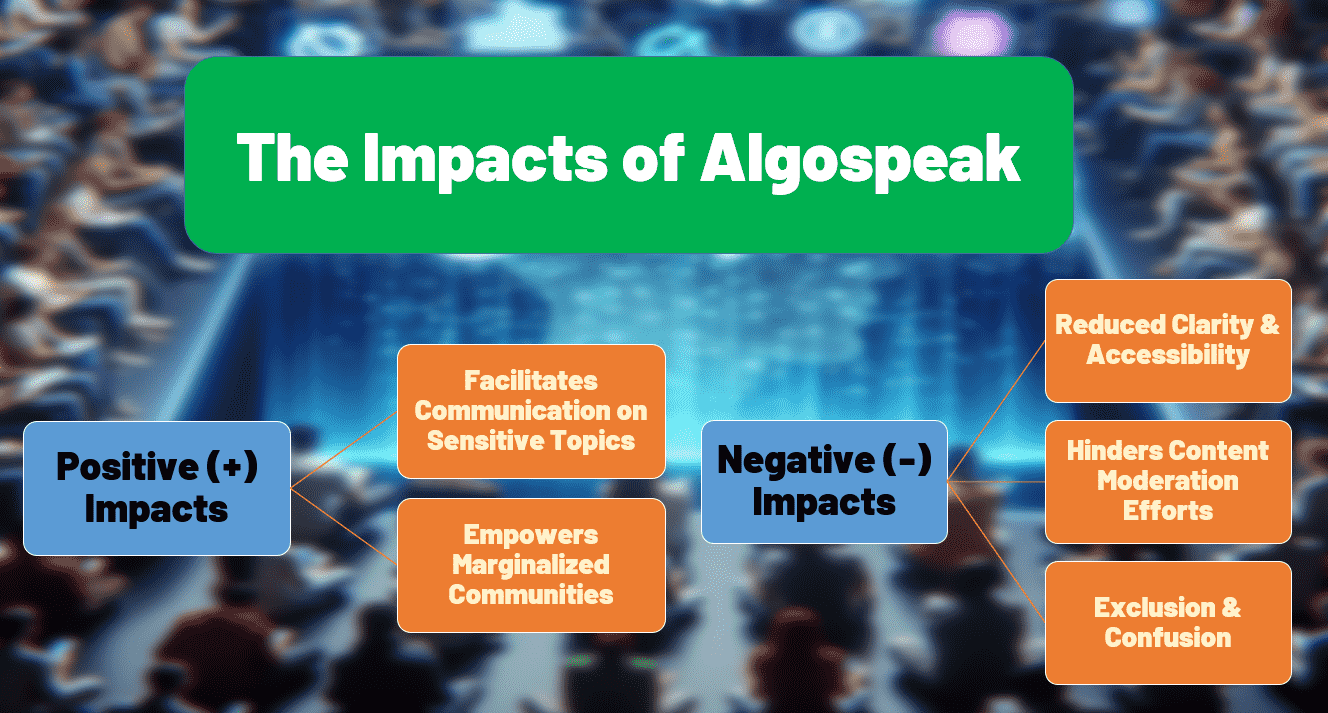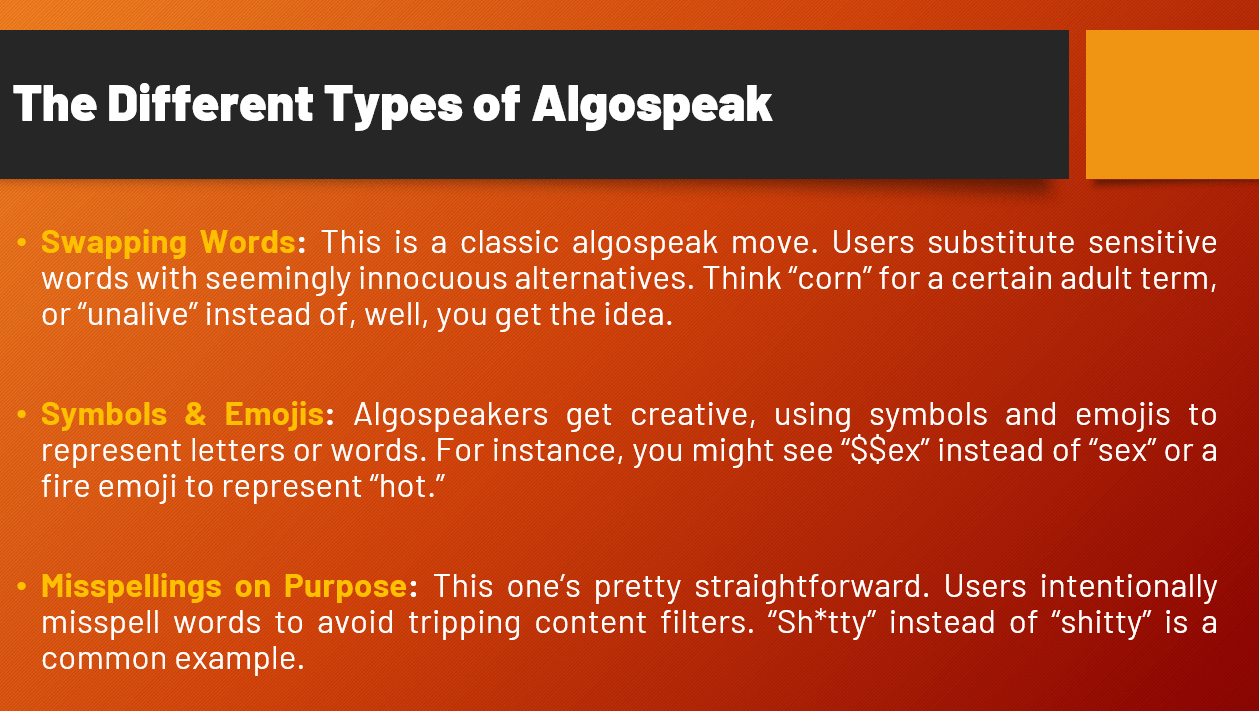What is Algospeak? Does It Work? + List and Examples
Why Does Algospeak Exist? + the Different Types of Algospeak
Communication, both old and new, is like a dance of signals. Even though it might seem complex, these signals are the building blocks of how we understand each other and get curious about what they mean. Imagine language as a big puzzle, packed with words jostling for attention. In virtual reality, language works like a chemical reaction, influencing how we use technology.
Your inner self, the part that makes you uniquely you, is a bit of a mystery. It’s like a secret identity that no one can quite pinpoint. We all pick up beliefs and ideas as we grow, mixing them with the symbols we encounter along the way.
Think about social media. Among all the memes and videos, have you ever stumbled upon posts that seem strangely mysterious? Maybe you’ve seen phrases that feel like they have hidden meanings.
In simple words: Ever scrolled through a social media post and scratched your head at seemingly nonsensical slang? Or maybe you’ve stumbled upon a comment where “corn” replaces a more, ahem, adult term? Welcome to the strange and evolving world of Algospeak! In this article from Twilinstok, we will respond to questions like: “What is Algospeak on Social Media?” and “Does it work?” We also suggest a list of 50 items for Algospeak. So stay tuned.
What is Algospeak?
Algospeak is like a rebellion against the norm, pushing boundaries to create fresh, contradictory language. To outsmart AI censorship, people twist sentences using different words or borrow someone else’s words. But this can confuse search engines, making similar essays seem plentiful.
Google and others try to keep up with these changes, but it’s tough. Algospeak is evolving fast, using hidden and imaginative words to fool even the smartest algorithms. Despite this challenge, it makes communication fun and easy.
💡 In simple words:
Algospeak refers to a coded language developed by online users to bypass content moderation systems on social media platforms. It’s essentially a secret handshake, a way for people to communicate about sensitive topics or express themselves freely, while seemingly avoiding the watchful eye of the algorithms.
Algospeak Meaning & Origin
Understanding Algospeak means digging into its roots and what it means for the digital world. Algospeak is like when digital culture meets algorithms. It’s a way for people to take back control of their online voices, especially with concerns about platform algorithms doing their own thing. It’s not just about dodging censorship anymore; it’s about changing how we talk online. Algospeak is evolving from simple tricks to strategic expressions, reshaping how we communicate in the digital space.

Why Does Algospeak Exist?
So, why has algospeak become a thing? Here in the US, we value open communication, but the rise of stricter content moderation has led some users to feel like they’re walking on eggshells. Here’s a breakdown of the reasons behind algospeak’s rise:

- Content Moderation on Steroids: Social media platforms are under increasing pressure to remove harmful content, from hate speech to violent threats. However, their algorithms can sometimes be a little overzealous, flagging legitimate content in the process. This frustration with overly restrictive filtering has prompted users to find workarounds.
- Algorithmic Bias: Let’s face it, algorithms aren’t perfect. They can sometimes misinterpret context or have inherent biases. This can lead to certain topics or communities being disproportionately affected by content moderation. Algospeak becomes a way for these communities to carve out a space for themselves online.
- The Desire for Community & Expression: The internet thrives on connection and the ability to express ourselves freely. Algospeak allows users to discuss sensitive topics or participate in marginalized communities that might face stricter moderation.
Examples of Algospeak
Deciphering Algospeak can be tough, but the key is uncovering the hidden meanings in seemingly ordinary phrases. Algospeak takes different forms, from coded words to outright evasion strategies. You can spot examples of Algospeak all over social media, like TikTok, Twitter, and Reddit. Terms like “blue bird app” may sound innocent, but they hold deeper significance that only those fluent in Algospeak can understand. It’s like turning beans into coffee; only those in the know can decode the hidden messages.
Algospeak list
Here’s a list of Algospeak terms explained in simple language:
- SMH: Stands for “Shaking My Head,” expressing disapproval or disappointment.
- NSFW: Not Safe For Work, indicating content that might be inappropriate for professional settings.
- GOAT: Greatest Of All Time, used for praising someone or something as the best.
- IYKWIM: If You Know What I Mean, implying a shared understanding of something unspoken.
- Bae: Originally a term of endearment for a romantic partner, now used more casually.
- Shook: Deeply surprised or disturbed.
- Lit: Excellent, exciting, or cool.
- Salty: Upset, bitter, or angry.
- Woke: Originally referred to social awareness, now sometimes used sarcastically.
- Finna: Contraction of “fixing to,” implying intention to do something.
- Lowkey/Highkey: Used to emphasize an opinion or feeling (lowkey = somewhat, highkey = very).
- Yeet: Expresses excitement, triumph, or the act of throwing something with force.
- Fire: Slang for something being excellent or impressive.
- Sus: Short for “suspicious,” implying someone or something is untrustworthy.
- Oof: Expresses disappointment, pain, or awkwardness.
- Deadass: Used for emphasis, meaning “seriously” or “completely.”
- Gucci: Originally a brand name, now used to mean “good” or “going well.”
- Tea: Gossip or secrets.
- Spill the Tea: To share gossip or secrets.
- Fam: Short for “family,” used to address close friends or a group.
- Cake: Slang term for money or wealth.
- Savage: Someone who is brutally honest or does something unexpected.
- Blessed: Feeling grateful or fortunate.
- Extra: Excessively dramatic or flamboyant.
- Bae caught me slippin’: A meme format implying getting caught doing something embarrassing.
- Woke mind blown: Expressing being surprised by something insightful or thought-provoking.
- Mood: A feeling, often expressed with an image or GIF.
- Salty AF: “AF” stands for “as f*ck,” emphasizing being very salty (upset).
- Ship: To support a romantic relationship between two people (often fictional characters).
- Yeet the negativity: Discarding negativity or bad vibes.
- Bussin’: Extremely good or delicious (often used for food).
- Big oof: An intensified version of “oof,” expressing major disappointment or awkwardness.
- Shookt: Past tense of “shook,” indicating something left you deeply surprised or disturbed.
- Wig snatched/flew: Used for something so amazing it metaphorically removes your wig.
- Low-key no cap: Emphasizes that something is true without exaggeration (low-key = somewhat, no cap = not lying).
- Sheesh: Expresses surprise, disbelief, or sometimes admiration.
- Finna woke: A sarcastic term for someone pretending to be socially conscious.
- Periodt: Used for emphasis, similar to “period” but often drawn out for comedic effect.
- Gucci gang: A reference to a popular song and meme, used to express feeling good or being part of a group.
- Snack: Someone considered attractive or desirable.
- Thirsty: Desperate for attention, especially romantically.
- Salty tears: Expresses bitterness or sadness, often used playfully.
- Fax: Short for “facts,” indicating agreement with a statement.
- No chill: Someone who is overly emotional or dramatic.
- WIG: Stands for “Weekend In Georgia,” a meme format often used for over-the-top reactions.
- Bruh: Expresses disbelief, frustration, or confusion. (Can also be gendered – “sis” or “dude”)
- Yeet yeet: More enthusiastic version of “yeet,” expressing excitement or celebration.
- Big mood: Strongly identifies with a particular feeling or situation.
- Glow-up: A significant improvement in appearance or overall success.
- Fire fit: A stylish or impressive outfit.
The Impact of Algospeak: A Double-Edged Sword
While algospeak can be a clever way to navigate the complexities of online communication, it’s not without its drawbacks. Here’s a look at both sides of the coin:

Positive Impacts:
- Facilitates Communication on Sensitive Topics: Algospeak can create a safe space for discussing sensitive issues or topics that might be flagged by overly cautious algorithms.
- Empowers Marginalized Communities: For communities facing stricter moderation due to algorithmic bias, algospeak can be a way to reclaim their voice and connect with each other.
Negative Impacts:
- Reduced Clarity & Accessibility: Coded language can be confusing for those not “in the know,” hindering clear communication and creating a barrier for new users.
- Hinders Content Moderation Efforts: By using algospeak, users can potentially bypass filters designed to remove harmful content, making it harder for platforms to maintain a safe online environment.
- Exclusion & Confusion: For those unaware of algospeak terminology, online conversations can become cryptic and exclusionary.
Understanding the Different Types of Algospeak
Now that we understand the why behind algospeak, let’s delve into the how. Here are some common tactics users employ:
- Swapping Words: This is a classic algospeak move. Users substitute sensitive words with seemingly innocuous alternatives. Think “corn” for a certain adult term, or “unalive” instead of, well, you get the idea.
- Symbols & Emojis: Algospeakers get creative, using symbols and emojis to represent letters or words. For instance, you might see “$$ex” instead of “sex” or a fire emoji to represent “hot.”
- Misspellings on Purpose: This one’s pretty straightforward. Users intentionally misspell words to avoid tripping content filters. “Sh*tty” instead of “shitty” is a common example.

The world of algospeak isn’t a one-size-fits-all situation. Just like fashion trends can vary between city streets and red carpets, algospeak usage can differ depending on the social media platform you’re on. Understanding these platform-specific nuances is key to effective online communication, whether you’re deciphering cryptic messages or crafting your own posts. Here’s a breakdown of how algospeak might manifest on different platforms:
Algospeak for TikTok
TikTok, known for its short-form video content and younger user base, is a breeding ground for creative algospeak. You might see trends like using abbreviations (“fr” for “for real”) alongside emojis and symbols to represent words within video captions or comments. Additionally, some algospeak terms specific to TikTok emerge and evolve rapidly due to the platform’s fast-paced nature.
Algospeak for Facebook
Facebook caters to a broader demographic and generally enforces stricter content moderation policies compared to TikTok. Here, algospeak users might resort to subtler tactics like deliberate misspellings or using synonyms to avoid triggering content filters.
Algospeak for Twitter (X)
The fast-paced nature of Twitter often leads to abbreviated language and internet slang, which can sometimes overlap with algospeak. However, users might also employ symbol substitutions or cleverly phrased euphemisms to bypass content moderation on sensitive topics.
Algospeak for Instagram
Instagram, with its focus on visual content and influencer culture, might see algospeak emerge in comments or captions. Users might leverage hashtags with hidden meanings or incorporate algospeak terms into their bios to connect with specific communities.
Algospeak for Reddit
Algospeak operates uniquely, much like how different Reddit forums have their own communities and ongoing discussions. However, within each subreddit, there’s also something called Anotespeak, which adapts to the specific behaviors and culture of that community.
Some individuals have mastered Algospeak so well that they stand out on these online platforms. They use coded language to delve into topics, express opinions in creative ways, share memorable experiences, and connect with like-minded people.
Reddit, with its strong community and desire to preserve its culture, embraces Algospeak as part of its identity. This evolution changes how people communicate and interact on the platform, shaping the very nature of online discourse.
It’s important to note that algospeak usage can vary depending on the platform. A term that flies under the radar on TikTok might get flagged on Facebook, due to each platform’s specific content moderation policies.

Does Algospeak Work?
The debate over whether “Algospeak” is effective for human interaction has been ongoing. Rather than solving the problem outright, using Algospeak seems more like a temporary fix. It’s like putting a bandage on a wound instead of treating it fully. We’re left wondering where this will take us in the long run.
Algorithms and human language are quite different. While human language can adapt to changes in user behavior, algorithms can also adjust themselves. This constant evolution leads to the creation of Algospeak, which is used in various ways. On the flip side, Algospeak can also be seen as a way for people to take control of their online presence and push back against the power of algorithms.
💡 Evolving Nature of Algospeak:
And just like fashion trends, algospeak is constantly evolving. As platforms refine their algorithms, users invent new coded terms to stay ahead of the game.
Conclusion
In today’s digital landscape, Algospeak stands out among other forms of communication, showcasing humanity’s creativity and adaptability. From its early days addressing algorithmic regulation to its current role as a tool for strategic expression, Algospeak embodies the ongoing battle for dominance in online spaces.
As platforms evolve and algorithms become more complex, the concept of Algospeak as a form of resistance also evolves. However, one thing remains constant: Algospeak provides users with a means of expression and resistance. It allows them to react and defend their online identities by exerting some level of control over their interactions in digital realms.
FAQs
What are some common examples of Algospeak?
Algospeak Expressions are many and range from slang and abbreviations, to the formation of words through cycles and wordplay. In this case, take “bean juice” as a stand-in for coffee and “blue bird app” for Twitter. This is an ordinary yet powerful new language called Algospeak.
How does algorithm awareness impact the use of Algospeak on social media platforms?
It is an essential element of Algospeak strategies since users starts to compete their language with each other with a focus on how to gain the most visibility and engagement while avoiding censoring rules of content moderation algorithms
Why is TikTok a hotspot for Algospeak experimentation?
TikTok’s algorithm driven content discovery system means that algorithms are the key to standing out within a surging sea of content. As a result, Algospeak becomes the safest haven in which the individual can showcase their unique qualities and style. The trending platform’s shareability and engagement are the key enablers of the tailored content making Algospeak a fertile playground.
Is Algospeak a sustainable long-term communication strategy?
Algotalk is an approach to the current content filtering algorithm and may work for a short while, however, its efficiency depends on factors like site policy, police user behavior as well as on the technology advancements.
How can individuals navigate the complexities of Algospeak in online discourse?
Learning the mechanisms of Algospeak, staying in touch with the platforms’ Terms & Conditions, and debating critically online content are different ways in which one can control the complexities of digital conversations successfully and competently.
Why are so many words censored on TikTok?
Censorship casts a shadow over the free expression of ideas on TikTok, as content moderators enforce strict policies that impact speech. Even innocuous content can run afoul of these rules, sometimes triggering algorithms designed to filter out sensitive topics. Despite efforts to censor, clever algorithms have emerged, sidestepping detection to convey messages that fly under the radar.
How TikTok has encouraged the rise of Algospeak?
People are resourceful in adapting to the ever-changing landscape of social media, especially on platforms like TikTok, where algorithms play a huge role in content visibility. They quickly pick up new words and phrases to navigate this digital world, leveraging the “view/share algorithm” to their advantage.
One of the key lessons learned in mastering Algospeak is the importance of creativity and thinking outside the box. By posting trendy content or using popular hashtags, users can drive traffic to their profiles and increase engagement. TikTok, with its multidimensional algorithmic transparency, serves as an ideal platform to explore the novelty of Newspeak in digital environments.

